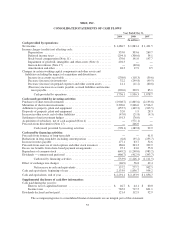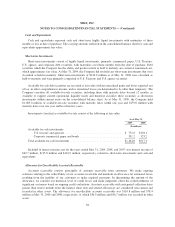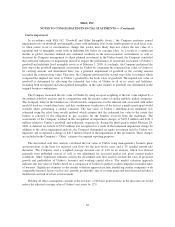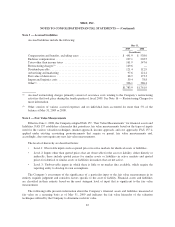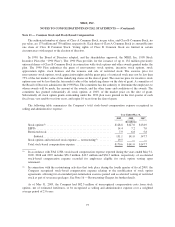Nike 2009 Annual Report Download - page 67
Download and view the complete annual report
Please find page 67 of the 2009 Nike annual report below. You can navigate through the pages in the report by either clicking on the pages listed below, or by using the keyword search tool below to find specific information within the annual report.NIKE, INC.
NOTES TO CONSOLIDATED FINANCIAL STATEMENTS — (Continued)
Umbro Impairment
In accordance with FAS 142 “Goodwill and Other Intangible Assets,” the Company performs annual
impairment tests on goodwill and intangible assets with indefinite lives in the fourth quarter of each fiscal year,
or when events occur or circumstances change that would, more likely than not, reduce the fair value of a
reporting unit or intangible assets with an indefinite life below its carrying value. As a result of a significant
decline in global consumer demand and continued weakness in the macroeconomic environment, as well as
decisions by Company management to adjust planned investment in the Umbro brand, the Company concluded
that sufficient indicators of impairment existed to require the performance of an interim assessment of Umbro’s
goodwill and indefinite lived intangible assets as of February 1, 2009. Accordingly, the Company performed the
first step of the goodwill impairment assessment for Umbro by comparing the estimated fair value of Umbro to
its carrying amount, and determined there was a potential impairment of goodwill as the carrying amount
exceeded the estimated fair value. Therefore, the Company performed the second step of the assessment which
compared the implied fair value of Umbro’s goodwill to the book value of goodwill. The implied fair value of
goodwill is determined by allocating the estimated fair value of Umbro to all of its assets and liabilities,
including both recognized and unrecognized intangibles, in the same manner as goodwill was determined in the
original business combination.
The Company measured the fair value of Umbro by using an equal weighting of the fair value implied by a
discounted cash flow analysis and by comparisons with the market values of similar publicly traded companies.
The Company believes the blended use of both models compensates for the inherent risk associated with either
model if used on a stand-alone basis, and this combination is indicative of the factors a market participant would
consider when performing a similar valuation. The fair value of Umbro’s indefinite-lived trademark was
estimated using the relief from royalty method, which assumes that the trademark has value to the extent that
Umbro is relieved of the obligation to pay royalties for the benefits received from the trademark. The
assessments of the Company resulted in the recognition of impairment charges of $199.3 million and $181.3
million related to Umbro’s goodwill and trademark, respectively, during the third quarter ended February 28,
2009. A deferred tax benefit of $54.5 million was recognized as a result of the trademark impairment charge. In
addition to the above impairment analysis, the Company determined an equity investment held by Umbro was
impaired, and recognized a charge of $20.7 million related to the impairment of this investment. These charges
are included in the Company’s “Other” category for segment reporting purposes.
The discounted cash flow analysis calculated the fair value of Umbro using management’s business plans
and projections as the basis for expected cash flows for the next twelve years and a 3% residual growth rate
thereafter. The Company used a weighted average discount rate of 14% in its analysis, which was derived
primarily from published sources as well as our adjustment for increased market risk given current market
conditions. Other significant estimates used in the discounted cash flow analysis include the rates of projected
growth and profitability of Umbro’s business and working capital effects. The market valuation approach
indicates the fair value of Umbro based on a comparison of Umbro to publicly traded companies in similar lines
of business. Significant estimates in the market valuation approach include identifying similar companies with
comparable business factors such as size, growth, profitability, mix of revenue generated from licensed and direct
distribution and risk of return on investment.
Holding all other assumptions constant at the test date, a 100 basis point increase in the discount rate would
reduce the adjusted carrying value of Umbro’s net assets by 12%.
65


